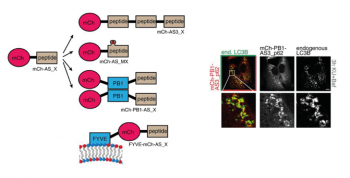06 Feb 2017 - Fluorescence-based sensors for specifically monitoring autophagy
Autophagy is a cellular recycling and quality control pathway that is essential for maintaining cellular metabolism and homeostasis. Its malfunction contributes e.g. to neurodegenerative diseases and cancer.
Ubiquitin-like ATG8 proteins constitute central components of the autophagic machinery. However, until today, it is not completely clear why yeast harbors only one ATG8 protein while human cells contain six mammalian ATG8 orthologs, classified into the LC3 and GABARAP subfamilies.
Using an interdisciplinary approach combining phage display with additional functional biochemical assays as well as cellular biology, the laboratories of Ivan Dikic and Andreas Ernst now engineered a valuable tool for studying specific functions of LC3 and GABARAP proteins. They developed fluorescence-based sensors that are able to discriminate between the six different members of the mammalian ATG8 protein family and track their actions within cells. As first application, the scientists successfully monitored the involvement of LC3C in selective autophagy of mitochondria (mitophagy) and Salmonella (xenophagy). The joint effort of the Dikic and Ernst groups has been published recently in EMBO Journal and will be helpful in decoding biological functions of individual LC3/GABARAP proteins.
